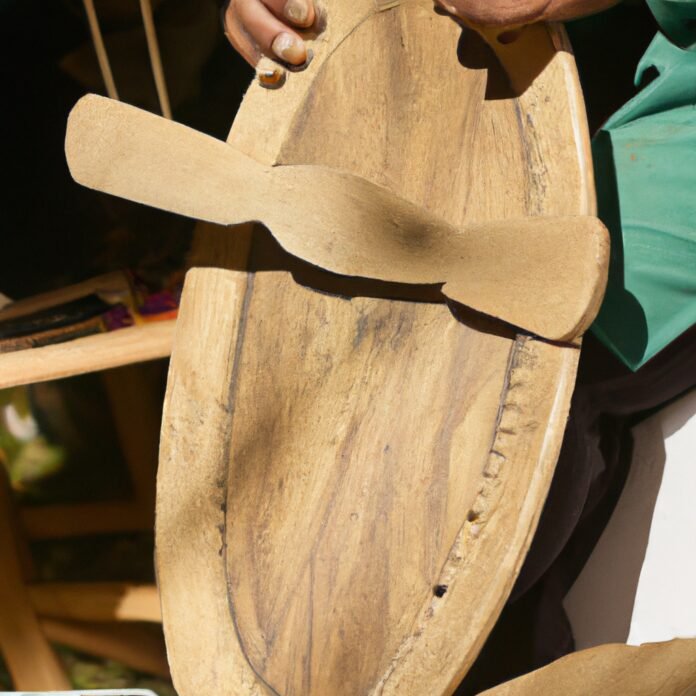Living in a world so wrapped in technology, it can be refreshing to take a step back and learn a skill passed down through generations of artisans. Traditional crafts offer something unique, from the art of candlemaking and peace of pottery to the rhythm of Japanese Taiko drumming. Together, these crafts carry with them a rich sense of cultural heritage and handmade beauty that modern machines will never be able to replicate. Join us as we explore the world of traditional crafts and learn the joy of artisanal techniques.
1. Exploring the World of Traditional Crafts
There’s something magical about traditional crafts. Every stitch of an intricate embroidered scarf, every woven thread of a handmade rug, and every bead of a beaded necklace carries within its exacting contours an invaluable part of a cultural heritage, passed down from generation to generation.
is a fascinating journey of discovering new-found skills, not just in the making but in the understanding and preservation of unique cultural identities. It’s a way of stepping into a creative process and being part of a movement that is dedicated to the appreciation and refinement of craft for generations to come.
Why is traditional craft so important?
- Traditional crafts represent a unique cultural identity and the dedication of a craftsperson.
- It is a way to preserve the skills and knowledge passed down from generations.
- It is a way to support local craftspeople, traditional artisans and cultural initiatives.
The world of traditional crafts is rich in stories, techniques and cultural diversity. Each handmade object connects us to the past in an immersive experience that celebrates the appetite for traditional craftsmanship and encourages its future preservation.
2. Capturing the Joy of Artisanal Techniques
Artisanal craftsmanship has long been a source of joy and admiration. Many of us feel a pull towards traditional techniques – the timelessness of knowing that something may be done time and time again with a consistent level of quality and satisfaction. Capturing the joy of these techniques is a great way to bring a little bit of the past into the present.
The beauty of artisanal techniques often lies in the details. Unpretentious yet skillfully executed, they form part of a much larger story. From the tools used to the materials sourced, every step in the process is done with consideration and the utmost care. Every tiny element is there for a reason and plays an important role in completing the craft.
Protecting and preserving these artisanal techniques is, and always will be, so important. Inviting more people to be part of it keeps the stories alive and channels the emotions and kindness from generation to generation. Here are some ideas on how to get involved:
- Learn – search for tutorials and short courses where you can learn the basics of a craft
- Try it – learn the techniques and put your own twist on them
- Connect – connect with the community, meet knowledgeable professionals, ask questions, join clubs and forums and get inspired
Acquiring skills, techniques and knowledge from traditional ways of craftsmanship, practicing them and bringing them to life is rewarding beyond words. There is poetry in crafts and a kind of meditative concentration that allows us to see the beauty of the process and cherish the finished product.
3. Understanding the Challenges of Crafting by Hand
Crafting by hand is an art form that is growing in popularity once more. But it can bring with it its own set of challenges.
Having the right tools. To craft with your hands you will need the right tools – which means acquiring them or learning how to work with the tools you have. Crafting without the right tool for the job can mean a much larger investment of time and can make the difference between a successful project and a ruined one.
Facing imperfections. Crafting by hand can lead to imperfections, even with the right tools. Crafting can be a good way to learn patience and perseverance when parts don’t fit or the finish isn’t quite right. The imperfections can lead to creative solutions that make a project look unique.
Time constraints. Crafting by hand can take longer than with manufactured pieces. Crafting can be a time consuming hobby and fitting in the crafting amidst other life demands can be difficult. It is worth remembering to take breaks and set realistic goals, so that the process of creating with your hands remains enjoyable.
- Invest in the right tools
- Be patient with imperfections
- Set realistic goals and take breaks
By understanding and managing the challenges that come with crafting by hand, you can enjoy the creative process and develop a satisfying, unique outcome.
4. Preserving the Beauty of Traditional Crafts
As with so many things, traditional crafts are objects of beauty. But these mementoes of past generations often require special care and attention if they are to survive and be enjoyed for many more years to come. Here are four tips for preserving the loveliness of traditional crafts:
- Handle with Care: Traditional crafts, such as pottery, embroidery, and knitting are all delicate and require gentle handling. Make sure your hands are clean and dry when touching to avoid staining or damaging the item.
- Low Humidity: Many forms of traditional crafts, particularly those made of wood, can be adversely affected by changes in humidity levels. Keep your traditional crafts in an area of consistent low humidity to prevent cracking and warping.
- Safe Storage: To ensure your traditional craft items remain in good condition, place them in a cool, dry storage container. Make sure the container is breathable and not airtight—placing your item in a sealed container will create an ideal environment for moisture and mold growth.
- Display with Caution: If you’re displaying a traditional craft item in your home or office, keep it away from sources of extreme heat and bright sunlight. This will protect it from discoloration or fading. For more fragile items, you may want to consider specially designed glass display cases for an extra layer of protection.
By following these simple tips, you can enjoy your traditional craft pieces for years to come. To make the most of your collection, why not learn more about the craft’s origins and gain deeper appreciation for what it represents. Then, you can pass the craft, and value of it, down to the next generation.
5. Taking the Craftsmanship of the Past Into the Future
Nothing is more finite than the craft of the past, and yet nothing is more infinite than the potential to bring it into the future. We can honor the traditional methods of the past and move them into the present.
Design
- Create a modern yet timeless look with classic materials.
- Incorporate feature pieces that pay homage to the past, while still fit with contemporary decor.
- Pay attention to traditional details such as cut glass, marble, and brass.
Techniques
- Maintain the structural integrity of the pieces by preserving historically significant techniques.
- Seamlessly blend in modern methods to update furniture, art, and craft for the 21st century.
- Keep the traditional tools and methods alive for future generations to experience.
Preservation
- Preserve the heritage of craftsmanship and its unique style through restoration and reconstruction.
- Appreciate and revere the care and workmanship present in past pieces.
- Share appreciation of the craftsmanship with family, friends, and the community.
Modernism doesn’t have to mean a complete break with the past. By leveraging craftsmanship of the past, we can move forward and build upon timeless works with newfound respect and admiration.
In today’s world, where technology reigns supreme, traditional crafts can represent a step back in time. By learning these artisanal techniques, we can connect to our past, helping us to understand and appreciate the history of craftsmanship. In many ways, the knowledge and skills of traditional crafts are more relevant than ever.

